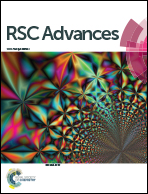The influence of hydrogen concentration in amorphous carbon films on mechanical properties and fluorine penetration: a density functional theory and ab initio molecular dynamics study†
Abstract
Amorphous carbon (a-C) films have attracted significant attention due to their reliable structures and superior mechanical, chemical and electronic properties, making them a strong candidate as an etch hard mask material for the fabrication of future integrated semiconductor devices. Density functional theory (DFT) calculations and ab initio molecular dynamics (AIMD) simulations were performed to investigate the energetics, structure, and mechanical properties of the a-C films with an increasing sp3 content by adjusting the atomic density or hydrogen content. A drastic increase in the bulk modulus is observed by increasing the atomic density of the a-C films, which suggests that it would be difficult for the films hardened by high atomic density to relieve the stress of the individual layers within the overall stack in integrated semiconductor devices. However, the addition of hydrogen into the a-C films has little effect on increasing the bulk modulus even though the sp3 content increases. For the F blocking nature, the change in the sp3 content by both atomic density and H concentration makes the diffusion barrier against the F atom even higher and suppresses the F diffusion, indicating that the F atom would follow the diffusion path passing through the sp2 carbon and not the sp3 carbon due to the significantly high barrier. For the material design of a-C films with adequate doped characteristics, our results can provide a new straightforward strategy to tailor the a-C films with excellent mechanical and other novel physical and chemical properties.



 Please wait while we load your content...
Please wait while we load your content...